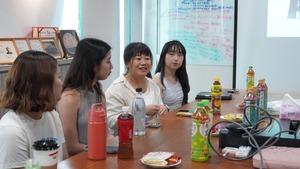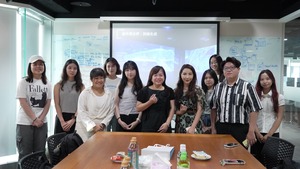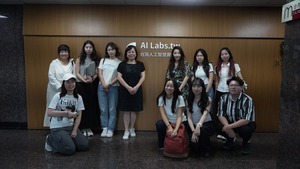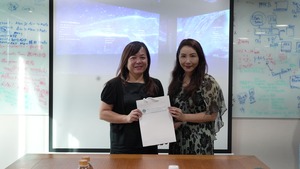GCIT Visits Taiwan AI Labs: Exploring the Competitive Edge of Interdisciplinary Talent in the Age of AI





【Article by GCIT】
As generative AI continues to evolve at lightning speed, the value of interdisciplinary talent is becoming increasingly vital. On September 26, Distinguished Professor Trisha Lin, Director of the Master’s Program in Global Communication and Innovation Technology (GCIT) at National Chengchi University, along with students and faculty, visited Taiwan AI Labs for an exclusive lecture and site tour.
Delivering the keynote speech was Huang Chao-Hui, Chief Content Officer of Taiwan AI Labs, who shared insights drawn from her multifaceted experience across media, education, and artificial intelligence. Her talk, titled “Interdisciplinary Talent in the AI Era: Focus on Excellence, Value Every Choice,” addressed the transformation of the media industry and why interdisciplinary backgrounds have become a key competitive advantage in the age of AI.
Chief Huang’s career spans diverse fields—including law, journalism, fact-checking, sustainable development and management, and AI technology. In addition to her role at Taiwan AI Labs, she serves as a board director at Taiwan FactCheck Center, Public Television Service (PTS), Chinese Television System (CTS), and Central News Agency (CNA), as well as a member of the Media Literacy Promotion Committee under Taiwan’s Ministry of Education.
Through vivid real-world examples, Ms. Huang illustrated how AI technologies are reshaping the media ecosystem and the skill sets required to thrive within it.
The Double-Edged Sword of AI and the Rise of Misinformation
Referencing an iconic Economist magazine cover, Ms. Huang posed a provocative question: “Is AI an angel or a devil?” While AI brings efficiency, it also introduces new risks. “When AI becomes too convenient, we outsource our brains,” she warned.
Recalling her time as a journalist, she could once remember hundreds of contact numbers by heart—today, she struggles to recall even her family’s phone number.
More concerning is AI’s so-called “hallucination” phenomenon. She provided examples, such as the Plain Law Movement, a legal team that once misquoted Taiwan’s Constitution due to AI-generated errors. She then shared that when ChatGPT just launched, the model’s responses about her identity changed each time—some even falsely claiming she acted in films. “AI speaks nonsense with a straight face. Without proper discernment, it’s nearly impossible to tell fact from fiction,” she said.
Media Survival and the Demand for Interdisciplinary Talent
Ms. Huang also addressed the existential challenges AI poses to journalism. With the launch of Google’s AI Overview, many media outlets have seen their websites traffic reduce greatly within just months. “Users used to click through multiple links to find answers. Now, AI delivers summaries instantly—people stop clicking into the pages, and both ad and subscription revenue vanish.” Even more troubling, she noted, is how tools like ChatGPT and Gemini absorb news content without compensating the journalists who created it.
Yet in this rapidly changing landscape, Ms. Huang believes interdisciplinary skills are the answer. She shared her own academic path: a law major with a double in philosophy, a master’s in journalism, and a doctoral focus on sustainability management—before joining Taiwan AI Labs three years ago. “I’m not a trained AI engineer, but my cross-domain experience gave me broader knowledge and stronger thinking methods, learning adaptability across fields.”
She pointed out that even in tech-heavy industries, domain-specific expertise alone is no longer enough. “This year, the U.S. saw record layoffs—not among artists or writers, but computer science graduates. Because pure coding jobs are the easiest for AI to replace.” What the market now values, she emphasized, are people who can bridge domains, understand humans’ needs, know how to ask practical questions, write precise prompts, and distinguish the good from the bad in AI-generated responses. “It’s not about what you majored in—it’s about whether your AI application skills outperform others.”
AI in Action: From Medical Imaging to Music
During the speech, Ms. Huang introduced GCIT students to a range of Taiwan AI Labs’ ongoing projects. In healthcare, for instance, AI systems can analyze brain tumor X-rays and offer treatment suggestions within 30 seconds. “A doctor may see a few ten thousand patients in a lifetime; AI can review tens of millions of cases—and remember them all."
In music, Taiwan AI Lab has partnered with musicians like Sandee Chan and Li Jian-Fu to preserve their voices with AI. “Some singers may not release new albums as they age, but with AI, we can save their best voices as cultural treasures.” The Hualien AI Music Lab now empowers people with no musical training to compose personalized songs. AI-generated news anchors, meanwhile, can deliver disaster alerts in multiple languages instantly. “In emergencies, reporters don’t need to risk their lives rushing to the studio—AI anchors can deliver real-time updates and disaster prevention information in Taiwanese, Hakka, or even Indigenous languages.”
Student Reflections and Final Advice
“I learned a lot about the real risks of AI, like bias and hallucinations, and how fact-checking plays a role. As a communication student, it’s crucial to understand both how AI works and how it’s applied in fields like music,” Mia, a first-year GCIT student, shared after the session.
“The most important thing in the AI era is to stay curious about the world. Asking the right questions matters more than having the right answers,” Ms. Huang ended her talk with encouragement. She stressed that emotional and perceptual capacities—such as empathy, creativity, and moral judgment—are irreplaceable. “What AI can’t replicate is the human ability to move one another, to feel deeply. That’s your core strength.”
She also urged students to remain open to interdisciplinary learning: “Don’t box yourself in. With AI as your tool, you can cross boundaries and explore any field—just stay curious, stay thoughtful, and stay human.”
This visit and talk offered GCIT students valuable industry insight—not only into the evolving capabilities and risks of AI, but also into the growing importance of interdisciplinary skills. It reflects GCIT’s ongoing mission to nurture globally-minded, tech-savvy communication professionals for the next generation.
[全球傳播與創新科技碩士學位學程獲文化部與教育部高等教育深耕計畫補助。]
